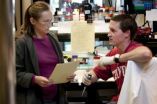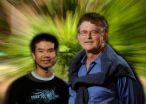(Press-News.org) Misfold an origami swan and the worst that happens is you wind up with an ugly paper duckling. Misfold one of the vital proteins in your body – each of which must be folded in a particular way to perform its function – and the result can be a debilitating neurodegenerative disease such as Alzheimer's or Huntington's.
There are no cures for such brain-wasting diseases, but now Stanford researchers have taken an important step that may one day aid in developing therapies for them. They have literally popped the lid off one of the microscopic chambers in which many of life's most crucial proteins are folded, witnessing a surprising mechanism as the heretofore hidden folding process happened before their eyes.
Virtually all proteins need to be folded, whether in primitive organisms such as bacteria or multicellular creatures such as humans. Many are guided through the process by molecules called chaperones, of which a specialized subset – chaperonins – folds many of the most complex proteins.
Folding in bacteria has been studied in detail, but Judith Frydman, a professor of biology who led the Stanford research, said this is the first time anyone has seen the folding process performed in higher organisms.
"The mechanism of folding we saw in the chaperonin is very different from what we expected and from what has been seen in bacteria," Frydman said. "It was really surprising, and we are still amazed that it worked. This chaperonin appears to provide a unique chemical environment."
Chaperonins are shaped like a barrel, with two ring-shaped chambers arranged one atop the other. At the open end of each ring is a lid that opens and closes in a spiraling fashion, like the aperture of a camera, something Frydman's team discovered in 2008 while studying the chaperonin called TRiC. Since then, they've been working to solve the puzzle of how a protein gets folded once the chaperonin has grabbed it, pulled it into the chamber and the aperture has closed. A paper describing their findings was published earlier this year in Cell.
Frydman said there were two likely ways in which a protein, initially a linear chain of molecules (amino acids), could theoretically be folded inside the chamber.
One is by mechanical means, with the chamber holding onto the protein and physically pushing it into the right shape.
"The other one is that when the lid closes, the chaperonin lets go of the protein, but some special chemical properties in this chamber somehow make it fold," she said. "Our evidence is that this mechanism is the correct one."
The only way to know which mechanism was doing the work was to see inside the chamber while the folding was happening, but simply opening up the lid wouldn't work, because the shape of the entire chamber changes in accordance with the motion of the lid. When the lid spirals open, the walls of the chamber spiral open, too, and the protein floats away.
To see what was happening, Frydman's team devised a chemical "trick" by which they could remove the lid on the chamber, but still get the walls of the chamber to close in, as if the lid were spiraling.
When they "closed" the lidless chamber, the chaperonin simply released the protein that had been destined to be folded. Like a long balloon that slipped from a child's grip before it could be folded into a giraffe, the protein simply drifted off.
The challenge then became figuring out how the protein was getting released.
"One of the reasons why the mechanical model of pushing the protein into shape without letting go had been proposed was because there was no obvious way for this chaperonin to let go of the protein," Frydman said.
When a protein gets grabbed for folding by TRiC, it is held by eight binding sites along the walls of the chamber. Between each binding site is a tiny loop. Frydman's team suspected that during the closing process, the loops might move to somehow "shave off" the protein and release it into the folding chamber. One of her students made mutations in the loop. When the researchers did experiments in which TRiC chaperonins equipped with mutated loops were closed, the protein stayed put. It also failed to fold.
"That suggests that the way this chaperonin folds its proteins is by releasing them in a closed chamber that has very special chemical properties," Frydman said.
"This mechanism of release is completely different from what has been seen in any other chaperone. That was very, very surprising."
The experimental work described in the Cell paper was done using a simpler version of TRiC, from a single-celled organism, than would be found in multi-cellular organisms, Frydman said, because the simpler version is much easier to manipulate.
"Now we are interested in going back to the eukaryotic [multi-cellular] complex, where every binding site in the folding chamber is different and every release loop is different," Frydman said. "I think this really opens up a lot of interesting avenues to explore how this works in higher organisms. Since TRiC helps fold many disease-linked proteins, and is central to protect cells from misfolding diseases such as Huntington's disease, this work could have many therapeutic applications."
INFORMATION:
Unprecedented view of protein folding may help develop brain disease therapies
2011-03-16
ELSE PRESS RELEASES FROM THIS DATE:
NwPlaza.com Offers Cashback Rewards Allowing Consumers to Save on Shopping and Travel Deals
2011-03-16
NwPlaza.com today announced the national availability of NwPlaza Cashback Rewards, an online comparison shopping platform designed to give back to shoppers for purchases on over 50 well-known and trusted merchants.
The NwPlaza Cashback Rewards Program, which can be found at http://www.nwplaza.com, helps consumers save money on these shopping categories:
- Books
- Electronics
- Nutrition
- Travel
- Office supplies
- Gift baskets
- Clothing
- Pet supplies
"When I received my Cashback Reward for travel booked through NwPlaza.com, I couldn't believe the amount ...
New device holds promise of making blood glucose testing easier for patients with diabetes
2011-03-16
TEMPE, Ariz – People with diabetes could be helped by a new type of self-monitoring blood glucose sensor being developed by Arizona State University engineers and clinicians at Mayo Clinic in Arizona.
More than 23 million people in the United States have diabetes. The disease is the fifth leading cause of death in the United States. It contributes to a higher risk for heart disease, blindness, kidney failure, lower extremity amputations and other chronic conditions.
Many people with diabetes suffer due to the difficulty of managing their blood glucose levels. It's recommended ...
NASA's Aqua Satellite spots rare Southern Atlantic sub-tropical storm
2011-03-16
NASA's Aqua satellite spotted some strong convection in a recently formed low pressure area that strengthened into Sub-Tropical Storm Arani in the South Atlantic. Arani formed near the coast of Brazil and is now moving away from it. Tropical cyclones in the Atlantic are a rare occurrence and since 2004 there have only been three of them, Arani being the third.
On March 14, 2011 at 1553 UTC (11:53 a.m. EST) the Atmospheric Infrared Sounder (AIRS) instrument that flies aboard NASA's Aqua satellite captured an infrared image of Sub-Tropical Storm Arani moving away from the ...
Large Hadron Collider could be world's first time machine
2011-03-16
If the latest theory of Tom Weiler and Chui Man Ho is right, the Large Hadron Collider – the world's largest atom smasher that started regular operation last year – could be the first machine capable causing matter to travel backwards in time.
"Our theory is a long shot," admitted Weiler, who is a physics professor at Vanderbilt University, "but it doesn't violate any laws of physics or experimental constraints."
One of the major goals of the collider is to find the elusive Higgs boson: the particle that physicists invoke to explain why particles like protons, neutrons ...
Toygaroo.com Launches Nation's Largest 'Online Toy Rental Service'
2011-03-16
Toygaroo.com, an innovative new toy rental company, has launched its online service, which will help families save money and go green by not having to throw out their old toys.
Toygaroo, which has a similar format to Netflix, allows families to rent toys for their children and provide a steady rotation of high-quality toys that can grow along with them. In addition, Toygaroo will be featured on the March 25 season premiere of ABC's "Shark Tank," a show that allows entrepreneurs to pitch their business ideas to successful investors.
"Any family with children understands ...
Insulin-releasing switch discovered
2011-03-16
Johns Hopkins researchers believe they have uncovered the molecular switch for the secretion of insulin — the hormone that regulates blood sugar — providing for the first time an explanation of this process. In a report published online March 1 in Cell Metabolism, the researchers say the work solves a longtime mystery and may lead to better treatments for type 2 diabetes, the most common form of the disease.
"Before our discovery, the mechanism behind how exactly the insulin-producing beta cells in the islet of Langerhans of the pancreas fail in type 2 diabetes was incompletely ...
Poorly presented risk statistics could misinform health decisions
2011-03-16
Choosing the appropriate way to present risk statistics is key to helping people make well-informed decisions. A new Cochrane Systematic Review found that health professionals and consumers may change their perceptions when the same risks and risk reductions are presented using alternative statistical formats.
Risk statistics can be used persuasively to present health interventions in different lights. The different ways of expressing risk can prove confusing and there has been much debate about how to improve the communication of health statistics.
For example, you ...
PURE Life Experiences Leads a Radical Shift in the Travel Industry: 85% of Travel Operators Agree That "Experiences" Are 7 Times More Important Than "Price" in the Differentiation of Their Offering
2011-03-16
Experts in the travel industry are progressively turning towards Experiential Travel and Transformational Travel to stand out in a much too undifferentiated, fusional and standardised world. A recent survey created by PURE confirms this trend: travel experts provided insightful information on the new challenges that operators in the industry will soon be facing and on how it is going to be all about the "experience". For the complete report, visit http://ww.purelifeexperiences.com/pureinsights.pdf.
According to the survey, 96.5% of Experiential suppliers agree that authentic ...
Newer antimalarials more effective than quinine against severe malaria
2011-03-16
Quinine should no longer be the drug of choice for treating severe malaria, according to an updated systematic review by Cochrane researchers. It is now evident that the antimalarial drug artesunate, which is derived from herbs used in Chinese medicine, is more effective at preventing death in patients with severe malaria.
Severe malaria occurs when the disease affects the function of vital organs. It is associated with rarer cerebral malaria, which affects the brain and can lead to long-term disability. More than a million people die each year from severe malaria, the ...
Tests on century-old equipment show how far X-rays have come
2011-03-16
OAK BROOK, Ill. – Researchers recently tested first-generation x-ray equipment from 1896 and found that it produced radiation doses and exposure times that were vastly higher than those of today's systems, according a study published online and in the May print edition of Radiology.
"To my knowledge, nobody had ever done systematic measurements on this equipment, since by the time one had the tools, these systems had been replaced by more sophisticated ones," said the study's lead author, Gerrit J. Kemerink, Ph.D., from Maastricht University Medical Center in the Netherlands.
Wilhelm ...




